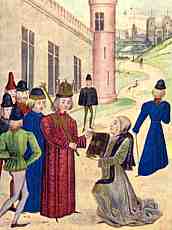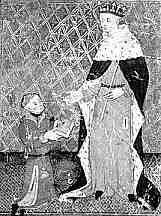 |
|
The
Laity (4) |
|
English
as a language of literacy came into its own in the 14th century, and the work
of Chaucer was highly influential in the development of the literate language.
The Canterbury Tales is not located in aristocratic
social space, but reflects a broader spectrum of society, both lay and clerical.
Chaucer also had a huge impact on English as a written language. While there
were many dialects being spoken in different regions of the country, the language
of Chaucer became the basis for written English. |
|
|
Portrait
of Chaucer from Hoccleve's Regement of Princes (British Library, Harley 4866,
f.88). By permission of the British Library. |
|
While
pragmatic literacy skills were increasing and developing, with practical
treatises in such areas as the law or rural estate management or animal
husbandry becoming prevalent, there was also an expansion of literature,
poetry and prose, which constituted reading for pleasure, or at least
for moral improvement. The increasing commercialisation and level of organisation
of the book trade turned out greater numbers of works for a growing proportion
of the population able to read them. Vernacular
works proliferated in all the languages of western Europe. |
 |
Froissart
presents his volume of love poetry to Richard II. |
 |
Hoccleve
presents his work to Henry V. |
|
Aristocratic
patronage may have assisted the process of production, but the readers
were also being drawn from the wealthy middle classes. Increased pragmatic
writing skills required for areas such as law and business were also utilised
for recreation, education and improvement to manners and morals. Books
of compilations appear, written in document
hands such as were used for business purposes, containing miscellanies
which included stories and poems as well as practical treatises. These
were collected volumes that readers were copying for themselves from various
sources. The business scripts
influenced the commercial production of books and copies which were rapidly
produced, free of the complex abbreviations of earlier works, written
on the cheaper medium of paper, made books accessible to more people.
Parkes has the most quotable quote on the subject: Books
were always a luxury in the Middle Ages, but the production of cheaper books
meant that they could become a luxury for poorer people. |
|
The
schools run by the clergy may have only catered for a small proportion
of the juvenile population at large, but they signified that the church
was generating literacy for more than just its own uses. Basic Latin,
like English, was escaping from the social space into which it had been
placed in the earlier period. |
|
|
The
15th century grammar school stands just outside the church door at Higham
Ferrers, Northamptonshire. |
|
As
far as religious ritual is concerned, wealthy or aristocratic lay patrons
had commissioned psalters
or breviaries
for their private use. However, these were not for them to read themselves
in a ritual context, but for the use of their private chaplains. The 14th
and 15th centuries saw a proliferation of a work which the laity could
use themselves for their daily ritual. This was the book
of hours. This was the most widely produced class of book of the late
middle ages, was the book most likely to be owned by a person of modest
means, and was significant in the development of lay literacy. |
 |
The
book of hours comprised a modified form of the divine
office and sets of prayers and psalms
for various occasions, to be used by members of the laity without the
presence of a priest. Most of them were in Latin, although there were
vernacular versions. Sometimes the rubrics
were in the vernacular, just to make it easier for a lay reader to find
their place or know where they were up to. The text was greatly adorned
with miniatures,
initials, rubrics and borders; all the usual pictorial elements to act
as prompts for the reading of the text. |
| Page from a 15th century book of hours (National Library of Australia, MS Clifford 1097/9, f. 65v). By permission of the National Library of Australia. |
| In the example
above, the miniatures of the cross and the crown of thorns precede prayers
in a series devoted to the passion, each preceded by an appropriate image. |
|
The
book of hours, or prymer
as it is also known, was used extensively for teaching children to read.
However, the type of literacy that this develops may be rather different
to what we would call true literacy today. The Latin would not have been
entirely unfamiliar, having been heard regularly during the church liturgy.
The use of the book of hours involved the daily repetition of the same
series of prayers, as well as the use of other prayers or psalms in the
book on specific occasions. There would, no doubt, be a certain amount
of rote learning by sheer repetition in this, aided by the illustrations
as a memory jogger. With a vernacular book of hours, one can see more
prospects for practical literacy, but when the book of hours was the only
book that some households owned, the opportunities to develop this skill
for pleasure or profit would seem to be severely limited. |
|
|
 previous page
previous page |
 The
Concept of Literacy The
Concept of Literacy |
|
 |
 |
 |
 |
 |
 |




